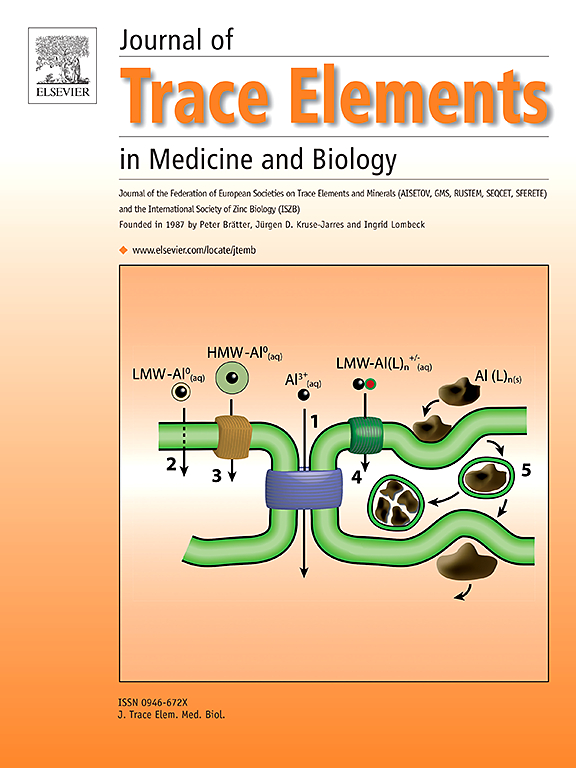新型铜复合物可抑制 DMBA 诱导的小鼠皮肤鳞状细胞癌中的蛋白酶体
IF 3.6
3区 医学
Q2 BIOCHEMISTRY & MOLECULAR BIOLOGY
Journal of Trace Elements in Medicine and Biology
Pub Date : 2024-09-18
DOI:10.1016/j.jtemb.2024.127533
引用次数: 0
摘要
蛋白酶体系统正成为多种疾病的治疗目标,尤其是癌症治疗。本研究旨在开发一种新型铜复合物,以抑制皮肤鳞状细胞癌中的蛋白酶体。研究人员首次合成了基于铜复合物的新分子,以评估其作为蛋白酶体抑制剂的潜力,特别是针对小鼠模型中由 7,12-二甲基苯并(a)蒽(DMBA)诱导的鳞状细胞癌。研究人员利用傅立叶变换红外光谱(FTIR)、X 射线衍射(XRD)、扫描电子显微镜(SEM)、核磁共振(NMR)和能量色散 X 射线分析(EDX)对这种新型铜复合物进行了表征。值得注意的是,组织病理学分析证实了乳头状瘤(皮肤肿瘤)的存在。随后的研究包括使用夹心酶联免疫吸附试验对蛋白酶体水平进行定量,并通过测量 7-氨基-4-甲基香豆素(AMC)裂解后发出的荧光来确定 20S 蛋白酶体的催化活性。因此,X 射线晶体学表明,所有的铜原子都是五配位的方阵构型,铜席夫碱基复合物具有很高的蛋白酶体抑制活性和生物活性,特别是对β5 亚基具有选择性。名为 Cu(L1)的铜复合物的药代动力学特性(ADMET)显示出令人鼓舞的结果,其毒性、分布和吸收均非常低。从 Cu(L1) 中获得的结构-活性关系(SAR)信息表明,它对β5 亚基具有选择性和强效抑制作用。因此,这种铜复合物已成为治疗皮肤癌的一种新型疗法。本文章由计算机程序翻译,如有差异,请以英文原文为准。
Novel copper complex inhibits the proteasome in skin squamous cell carcinoma induced by DMBA in mice
The proteasomal system is becoming a target for the treatment of several diseases, especially in cancer therapy. The present study aims to develop a novel copper complex that inhibits the proteasome in skin squamous cell carcinoma. New molecules based on the copper complex were synthesized for the first time to assess their potential as proteasome inhibitors, specifically targeting squamous cell carcinoma induced by 7,12-dimethylbenz(a)anthracene (DMBA) in mouse models. Fourier Transform Infrared (FTIR), X-ray diffraction (XRD), scanning electron microscopy (SEM), nuclear magnetic resonance (NMR), and energy dispersive X-ray analysis (EDX) were carried out to characterize this new copper complex. Notably, the presence of a papilloma (skin tumor) was confirmed by histopathological analysis. Subsequent investigation included the quantification of proteasome levels using a sandwich ELISA test, and the catalytic activity of the 20S proteasome was determined by measuring the fluorescence emitted after the cleavage of 7-amino-4-methylcoumarin (AMC). Hence, X-ray crystallography indicates that all Cu atoms are five-coordinated in a square-pyramidal configuration and biological activity of copper Schiff base complex, which exhibits high proteasome inhibitory activities with particular selectivity of β5 subunit. The pharmacokinetic properties (ADMET) of the copper complex named Cu(L1) showed encouraging results with very low toxicity, distribution, and absorption. Structure–activity relationship (SAR) information obtained from Cu(L1) demonstrated its selectivity and potent inhibition for β5 subunit. In this regard, this copper complex has emerged as a novel therapy for skin cancer.
求助全文
通过发布文献求助,成功后即可免费获取论文全文。
去求助
来源期刊
CiteScore
6.60
自引率
2.90%
发文量
202
审稿时长
85 days
期刊介绍:
The journal provides the reader with a thorough description of theoretical and applied aspects of trace elements in medicine and biology and is devoted to the advancement of scientific knowledge about trace elements and trace element species. Trace elements play essential roles in the maintenance of physiological processes. During the last decades there has been a great deal of scientific investigation about the function and binding of trace elements. The Journal of Trace Elements in Medicine and Biology focuses on the description and dissemination of scientific results concerning the role of trace elements with respect to their mode of action in health and disease and nutritional importance. Progress in the knowledge of the biological role of trace elements depends, however, on advances in trace elements chemistry. Thus the Journal of Trace Elements in Medicine and Biology will include only those papers that base their results on proven analytical methods.
Also, we only publish those articles in which the quality assurance regarding the execution of experiments and achievement of results is guaranteed.

 求助内容:
求助内容: 应助结果提醒方式:
应助结果提醒方式:


